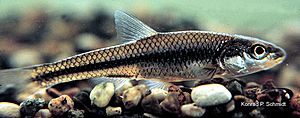Bigmouth shiner facts for kids
Quick facts for kids Bigmouth shiner |
|
|---|---|
 |
|
| Conservation status | |
| Scientific classification | |
| Synonyms | |
|
The bigmouth shiner (Notropis dorsalis) is a small fish, a type of minnow, found in many parts of the United States. It's one of the 324 different kinds of fish living in Tennessee. You can find this common minnow in the Midwest, and even as far east as the Atlantic coast. Scientists are still learning a lot about this fish, especially its habits and how it lives. Often, you'll find bigmouth shiners swimming alongside common shiners in streams.
Contents
What Does a Bigmouth Shiner Look Like?
The bigmouth shiner is a small fish, usually growing to about 3 inches long. It has a grayish-yellow back and shiny silver sides and belly. A dark stripe runs down the middle of its body.
One special thing about the bigmouth shiner is its mouth. It has a "subterminal" mouth, which means its upper jaw hangs over its wide lower jaw. This is a key feature that helps identify this species. Like other minnows, the bigmouth shiner has one dorsal fin (the fin on its back) with fewer than ten soft fin rays.
Where Do Bigmouth Shiners Live?
Bigmouth shiners are native to North America. They are commonly found in the Great Lakes, Hudson Bay, and Mississippi River areas. You can also spot them in the Platte River system, and in states like Iowa, Illinois, and Arkansas. They live as far east as western New York and Pennsylvania, and in northern West Virginia.
Scientists sometimes recognize three different types, or subspecies, of bigmouth shiners: Notropis dorsalis dorsalis, N. d. piptolepis, and N. d. keimi.
These fish prefer to live in shallow streams where the water moves quickly. They can also be found in shallow pools at the start of rivers, and in small to medium-sized rivers that have sandy bottoms.
What Do Bigmouth Shiners Eat?
Bigmouth shiners enjoy eating small creatures that live in the water, called aquatic invertebrates. They also eat insects that fall into the water from land. Sometimes, they munch on algae and other small plants found at the bottom of streams.
How Do Bigmouth Shiners Reproduce?
Not much is known about how bigmouth shiners have babies. However, we do know that they lay their eggs between May and August. They usually spawn (release their eggs) upstream, allowing the eggs to float downstream with the current.
Bigmouth Shiner Populations
Interestingly, bigmouth shiners seem to do well in streams where humans have made changes, like creating channels. This means human activity can sometimes help their populations.
In Ohio, bigmouth shiners face competition from an invasive fish called the silverjaw minnow. This competition has caused some bigmouth shiner populations to shrink. To help these fish survive, people can work to reduce pollution and stop riverbanks from eroding.
In Missouri, young bigmouth shiners grow to about 0.8 to 1.6 inches long by the end of their first summer. They likely become old enough to reproduce during their second summer.


